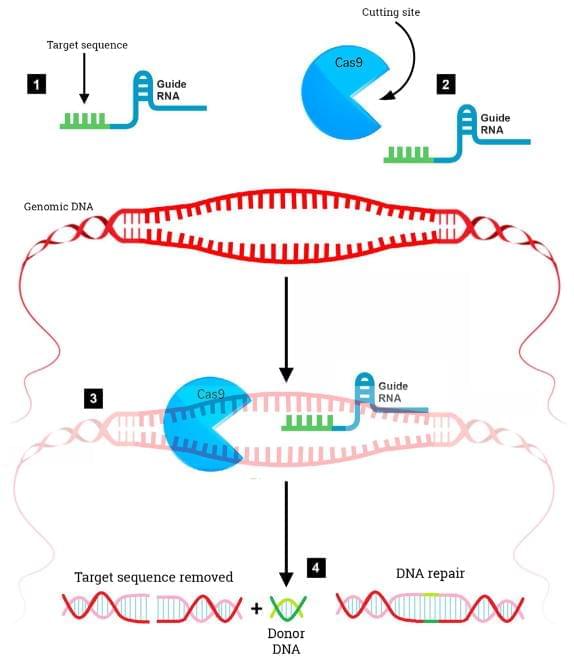
Get the latest international news and world events from around the world.


‘Cannibal’ coronal mass ejection will hit Earth at nearly 2 million mph, scientists say
The sunspot, called AR2975, has been shooting out flares of electrically charged particles from the sun’s plasma soup since Monday (March 28). Sunspots are areas on the sun’s surface where powerful magnetic fields, created by the flow of electrical charges, knot into kinks before suddenly snapping. The resulting release of energy launches bursts of radiation called solar flares, or explosive jets of solar material called coronal mass ejections (CMEs).
Related: Strange new type of solar wave defies physics
Cannibal coronal mass ejections happen when fast-moving solar eruptions overtake earlier eruptions in the same region of space, sweeping up charged particles to form a giant, combined wavefront that triggers a powerful geomagnetic storm.

The Potential of CRISPR/Cas9 Gene Editing as a Treatment Strategy for Alzheimer’s Disease
Despite a wealth of knowledge gained in the past three decades concerning the molecular underpinnings of Alzheimer’s disease (AD), progress towards obtaining effective, disease modifying therapies has proven to be challenging. In this manner, numerous clinical trials targeting the production, aggregation, and toxicity of beta-amyloid, have failed to meet efficacy standards. This puts into question the beta-amyloid hypothesis and suggests that additional treatment strategies should be explored. The recent emergence of CRISPR/Cas9 gene editing as a relatively straightforward, inexpensive, and precise system has led to an increased interest of applying this technique in AD. CRISPR/Cas9 gene editing can be used as a direct treatment approach or to help establish better animal models that more faithfully mimic human neurodegenerative diseases. In this manner, this technique has already shown promise in other neurological disorders, such as Huntington’s disease. The purpose of this review is to examine the potential utility of CRISPR/Cas9 as a treatment option for AD by targeting specific genes including those that cause early-onset AD, as well as those that are significant risk factors for late-onset AD such as the apolipoprotein E4 (APOE4) gene.
Keywords: Alzheimer’s disease, CRISPR/Cas9, Gene editing, Treatment, Huntington’s disease, iPSC neurons.
Alzheimer’s Disease (AD) is a progressive and fatal neurodegenerative disorder that primarily affects older adults and is the most common cause of dementia [1]. Currently it afflicts 5.5 million Americans and that number is expected to triple by 2050. At the present time, it is the third leading cause of death behind heart disease and cancer, with an estimated 700,000 Americans ages65 years will have AD when they die [2]. In addition, the cost of the disease is substantial with $259 billion health care dollars going to manage the disease currently, and by the middle of the century costs are predicted to soar over $1.2 trillion, which will completely bankrupt the healthcare system in the USA [3]. Worldwide, 47 million people live with dementia and that number is projected to increase to more than 131 million by 2050 with an estimated worldwide cost of US $818 billion [4].

HB11 Energy demonstrates nuclear fusion using high-power lasers
Australia’s first fusion energy company HB11 Energy has demonstrated a world-first ‘material’ number of fusion reactions by a private company, producing ten times more fusion reactions than expected based on earlier experiments at the same facility. The technology utilizes high-power, high-precision lasers to start non-thermal fusion reactions between hydrogen and boron-11 rather than heating hydrogen isotopes to hundred-million-degrees temperatures.
This approach was predicted in the 1970s at UNSW by Australian theoretical physicist and HB11 Energy co-founder Professor Heinrich Hora. It differs radically from most other fusion efforts to date that require heating of hydrogen isotopes to millions of degrees.
Nuclear fusion powers the Sun and other stars as hydrogen atoms fuse together to form helium, and the matter is converted into energy. The Sun accomplishes fusion by having a huge amount of hydrogen atoms packed into a plasma that’s superheated to tens of millions of degrees at its core. At these temperatures, the hydrogen atoms move so fast and eventually reach speeds high enough to bring the ions close enough together that they smack into each other and fuse, releasing the energy that warms our planet.

Researchers discover source of super-fast electron rain
UCLA scientists have discovered a new source of super-fast, energetic electrons raining down on Earth, a phenomenon that contributes to the colorful aurora borealis but also poses hazards to satellites, spacecraft and astronauts.
The researchers observed unexpected, rapid “electron precipitation” from low-Earth orbit using the ELFIN mission, a pair of tiny satellites built and operated on the UCLA campus by undergraduate and graduate students guided by a small team of staff mentors.
By combining the ELFIN data with more distant observations from NASA’s THEMIS spacecraft, the scientists determined that the sudden downpour was caused by whistler waves, a type of electromagnetic wave that ripples through plasma in space and affects electrons in the Earth’s magnetosphere, causing them to “spill over” into the atmosphere.

Shanghai’s Physical 2.0: When Gyming Meets Clubbing
PANORAMA Design Group bagged the 2021 Asia-Pacific Space Designers Association (APSDA) Gold Prize in the Entertainment & Leisure category with their project, Physical 2.0. Combining the two popular social activities among young people, Physical 2.0 aims to create a novel experience for fitness with clubbing elements.
“Our pleasure to receive many recognitions in the inaugural APSDA Awards,” said PANORAMA Design Group. “It’s a solid confirmation for the values and unique experience PANORAMA has created for the users in different spatial typologies.”

Fruit packing robot dramatically cuts packhouse labor needs
Now, an intelligent robotic fruit packing machine is able to automate the most labor-intensive job in the packhouse. For post-harvest operators, this robot could prove to be a game-changer in the industry.
The Aporo II robotic produce packaging machine by Globe Pac Technologies builds on the proven technology of the original Aporo I Produce Packer. First developed in 2018, the latest model can now accommodate twice the throughput, packing 240 fruit per minute, saving between two and four labor units per double packing belt.
According to Cameron McInness, Director of Jenkins Group, a New Zealand-based company which co-founded Global Pac Technologies with US-based Van Doren Sales Inc, Aporo II can be retrofitted across two packing belts instead of one, effectively doubling the throughput and the labor-saving that Aporo I could deliver.
Will there be Human-Level Artificial Intelligence by 2030?
Artificial Intelligence has been improving rapidly these past few years, and it’s now becoming obvious according to the top AI Scientists such as Yann LeCun that AI in 2030 will be almost unrecognizable compared to ones right now. They will be part of everyday lifes in the form of digital assistants and more. What other awesome abilities the best AI of the future will have, I’ll show you in this future predictions video.
–
TIMESTAMPS:
00:00 The first Human-Level AI
01:34 What are SSL World Models?
02:26 What is Self Supervised Learning?
05:24 Learning like Humans.
09:14 The Implications of Human AI
10:57 Last Words.
–
#ai #agi #technology
